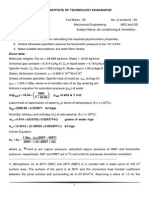Assignment 2
Uploaded by
Dhirendra MishraAssignment 2
Uploaded by
Dhirendra MishraAssignment # 2
1. Show that the mass of a vertical column of air of unit cross-sectional area in a hydrostatic
atmosphere extending from the ground to very great heights equals p o/g, where po is the
surface pressure and g is the acceleration due to gravity. Also estimates the total mass of
the atmosphere.
2. Find the saturation adiabatic lapse rate of the air at 26oC, pressure of 1013 hPa and
having saturation –mixing ratio is 21.85g kg-1. Use the specific heat at constant pressure
of dry air = 1004 Jkg-1K-1.
3. An air parcel at 1000 mbar has a temperature of 20oC and a mixing ratio of 10 g kg-1. The
parcel is lifted to 700 mbar by passing over mountain. During the ascent 80% of the
water vapor that condenses falls out of the parcel. Find the temperature and potential
temperature of the air when it returns to 1000 mbar on the other side of mountain.
4. Describes the relations between the all thermodynamic diagrams in terms of energy,
temperature, pressure, temp vs potential temp angle, potential temperature and lapse rate.
5. Derive a formula for the dependence of density upon height in an atmosphere of constant
lapse rate of temperature.
6. What is the elevation in the geopotential feet if a pressure of 700 mb is found on a certain
day to be at an elevation of 3000 geopotential meters?
7. Show that the rate of change of temperature with height in a homogeneous atmosphere is
constant and about six times larger than the temperature decreases normally in the lower
atmosphere.
8. A thickness atmosphere layer is isothermal with temperature -3 oC. A dry parcel is given
an upward impetus which is enough to cause the parcel to rise 1km above its original
level before it begins to sink again. Calculate the energy per unit mass which had to be
imparted to the parcel to produce this displacement (T= 273K).
9. Show that Γs ≤ Γd in the mathematical range of temperature.
10. Calculate the numerical value of the saturated pseudo adiabatic lapse rate in oC km-1 for p
= 300mb and T = -20oC.
You might also like
- Assignment 1: Standard Atmosphere: is given the symbol δ,0% (1)Assignment 1: Standard Atmosphere: is given the symbol δ,1 page
- H. Sta. Maria - Thermodynamics (Selected and Modified Problems)No ratings yetH. Sta. Maria - Thermodynamics (Selected and Modified Problems)20 pages
- Do Not Use Tables in Appendix A or B, Unless Stated OtherwiseNo ratings yetDo Not Use Tables in Appendix A or B, Unless Stated Otherwise2 pages
- Electric Power Distribution System Turan Gonen-812No ratings yetElectric Power Distribution System Turan Gonen-8121 page
- answer of propblem.pdf - 2023.02.03 - 12.37.05pmNo ratings yetanswer of propblem.pdf - 2023.02.03 - 12.37.05pm5 pages
- Atmosphere, Ocean and Climate Dynamics Answers to Chapter 1: const r gδr rNo ratings yetAtmosphere, Ocean and Climate Dynamics Answers to Chapter 1: const r gδr r2 pages
- Unit III - Air Pollution Thermodynamics - Class 4No ratings yetUnit III - Air Pollution Thermodynamics - Class 415 pages
- CH1140: Thermodynamic Laws and Phase Transitions Assignment-1No ratings yetCH1140: Thermodynamic Laws and Phase Transitions Assignment-12 pages
- OC 450 Climatic Extremes Problem #1 Due: Friday, Jan 16No ratings yetOC 450 Climatic Extremes Problem #1 Due: Friday, Jan 165 pages
- Atmospheric Thermodynamics: Consiglio Nazionale Delle Ricerche - Istituto Di Scienze Dell'atmosfera e Del Clima ItalyNo ratings yetAtmospheric Thermodynamics: Consiglio Nazionale Delle Ricerche - Istituto Di Scienze Dell'atmosfera e Del Clima Italy25 pages
- A Set of Solved Problems Convective CorrelationNo ratings yetA Set of Solved Problems Convective Correlation9 pages
- Psychrometric Processes: 1. Sensible Heating or CoolingNo ratings yetPsychrometric Processes: 1. Sensible Heating or Cooling5 pages
- Lecture - 5: The Contents of This Lecture Are As Follows: 1.0 Some of The Theoretical Concepts Involved in Heat FlowNo ratings yetLecture - 5: The Contents of This Lecture Are As Follows: 1.0 Some of The Theoretical Concepts Involved in Heat Flow7 pages
- CH1140: Thermodynamic Laws and Phase Transitions Assignment-1 (Chapter 1 Cengel, Boles and Kanoglu)No ratings yetCH1140: Thermodynamic Laws and Phase Transitions Assignment-1 (Chapter 1 Cengel, Boles and Kanoglu)3 pages
- Pressure, Heat and Temperature - Physics for Kids - 5th Grade | Children's Physics BooksFrom EverandPressure, Heat and Temperature - Physics for Kids - 5th Grade | Children's Physics BooksNo ratings yet



























































